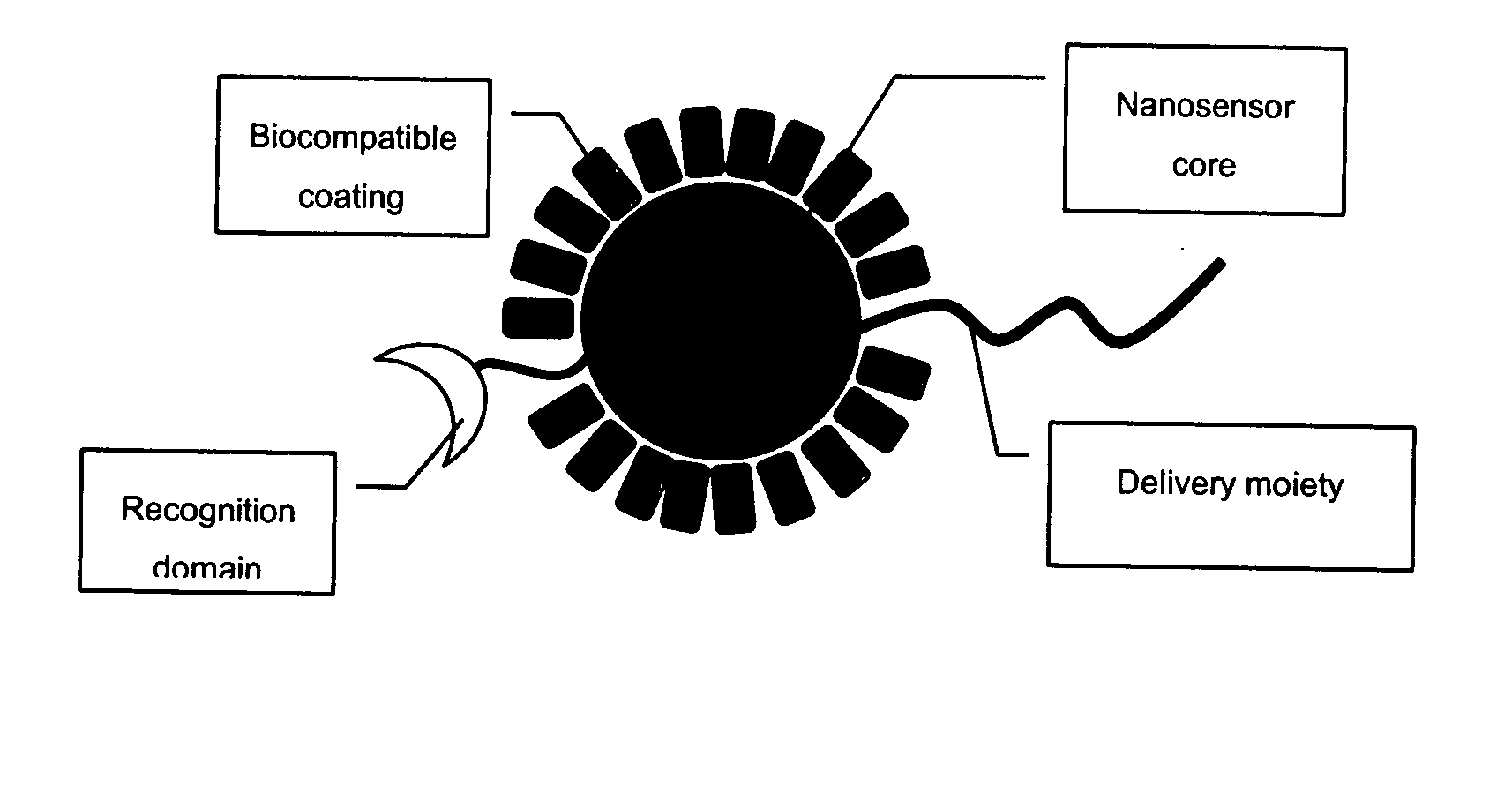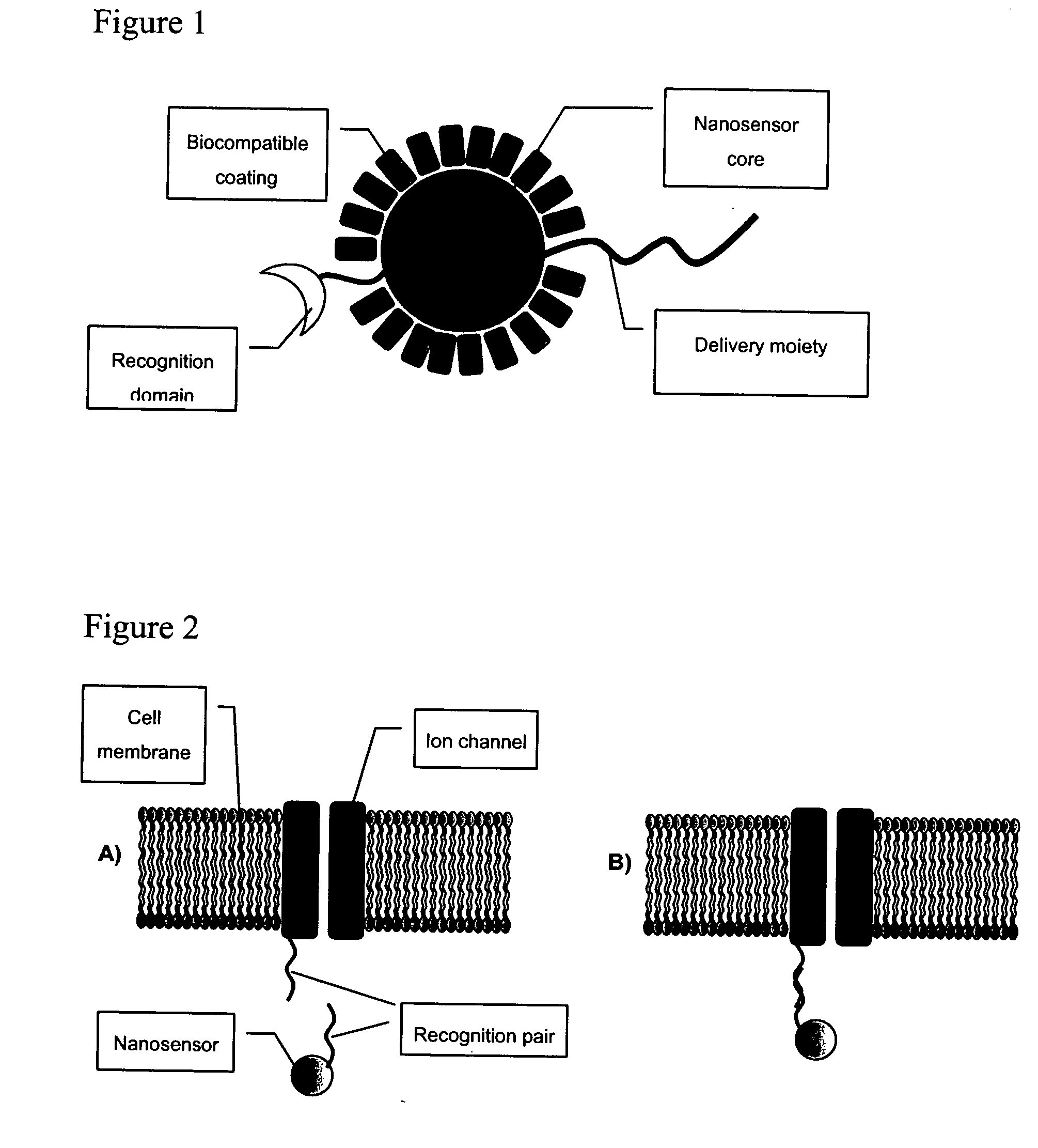Detection of ion channel or receptor activity
a technology applied in the field of detection of ion channel or receptor activity, can solve the problems of inability to distinguish signals, large number of false-positive hits, and technical liability, and achieve high information content, high throughput, and rapid acquisition of reliable results.
- Summary
- Abstract
- Description
- Claims
- Application Information
AI Technical Summary
Benefits of technology
Problems solved by technology
Method used
Image
Examples
example 1
Synthesis and Spectral Properties of Plasmon Resonant Gold Nanoparticles
[0343] Materials and Methods
[0344] Synthesis of gold nanoparticles. All glassware was cleaned in aqua regia and rinsed with ultrafiltered water before use. 200 mL of a 0.25 mM aqueous solution of HAuCl4 were brought to a boil (plate temperature 280° C.) under constant, vigorous stirring (440 rpm). The pH of this solution was adjusted to 7 by addition of 120 μL of a 0.5 M aqueous solution of NaOH. 3.4 mL of a 50 mM solution of trisodium citrate were then added at a constant rate (approximately in 2 s). The solution slowly changed color: from transparent, to grey, purple and finally orange-red after circa ½ h. The heat was then turned off, but stirring was continued until the solution cooled to room temperature.
[0345] Modification of gold particles' surface for calcium sensitivity with MUA. A solution of 25 mM mercaptoundecanoic acid (MUA) was prepared by sonicating the powder for 10 min in a 50% water / ethanol ...
example 2
Sensitivity and Specificity of Peptide-Functionalized Nanoscale Sensors to Calcium Ions
[0349] Gold nanoparticles (˜2 nM) were coated with a peptide displaying asparagine groups to the environment made and functionalized as in Example 1, using 34 mM peptide and the peptide CALNN (SEQ ID NO: 13). Following synthesis and functionalization, and after repeated washes in PBS by centrifugation and resuspension, nanoparticles were incubated in a solution containing either calcium or magnesium in water at a range of different concentrations. FIG. 16A shows the absorption spectrum of peptide-modified nanoparticles in the presence of various concentrations of calcium. The particles selectively chelate calcium ions, an event leading to their aggregation, which is readily detected by a spectral change in the presence of 1 mM Ca++, relative to the spectrum at lower Ca++ concentrations. Particle aggregation in the presence of Ca++ is evident in FIG. 16B, left tube—note the colored particles at th...
example 3
Synthesis and Characterization of Calcium-Sensitive Polyacrylic Acid Coated Nanoparticles
[0350] Materials and Methods
[0351] Coating of gold nanoparticles with polyacrylic acid (PAA) for calcium sensitivity. Gold nanoparticles of diameter ˜15 nm were synthesized and coated with a monolayer of mercaptoundecanoic acid (MUA), according to the methods described in Example 1. After coating with MUA, particles carry a negative surface charge, due to the presence of carboxyl groups. In order to coat them with polyacrylic acid—also negatively charged—a layer of a positively charged polymer is first added. Particles were therefore coated with poly-diallyl-dimethylammonium-chloride (PDADMAC) by incubating them for ½ h in an aqueous solution of 10 mM NaCl, also containing 0.1% PDADMAC (20 KDa). The excess polymer was removed by centrifugation of the particles, removal of the supernatant and resuspension. In order to obtain the final layer of large-coiled polyacrylic acid, one needs to maximiz...
PUM
 Login to View More
Login to View More Abstract
Description
Claims
Application Information
 Login to View More
Login to View More - R&D
- Intellectual Property
- Life Sciences
- Materials
- Tech Scout
- Unparalleled Data Quality
- Higher Quality Content
- 60% Fewer Hallucinations
Browse by: Latest US Patents, China's latest patents, Technical Efficacy Thesaurus, Application Domain, Technology Topic, Popular Technical Reports.
© 2025 PatSnap. All rights reserved.Legal|Privacy policy|Modern Slavery Act Transparency Statement|Sitemap|About US| Contact US: help@patsnap.com



